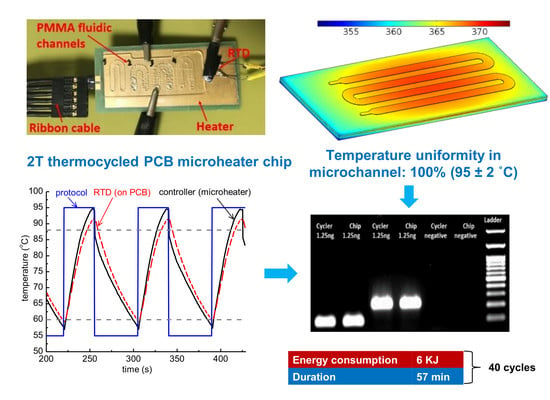Towards PCB-Based Miniaturized Thermocyclers for DNA Amplification
Abstract
1. Introduction
2. Materials and Fabrication, Methods, and Calculations
2.1. Printed Circuit Board (PCB) Microheaters
2.2. Poly(methyl Methacrylate) PMMA Microfluidics
2.3. Temperature Verification via Resistance Temperature Detectors
2.4. Biological Protocols
2.5. The Modeling Framework
3. Results and Discussion
3.1. Experimental
3.1.1. Optimization of a Two-Temperature Polymerase Chain Reaction (PCR) Protocol
3.1.2. Thermocycling with a Thick PCB Microheater Chip
3.1.3. Temperature Uniformity on PCB Microheater Chips
3.1.4. Thermocycling with a thin PCB Microheater Chip
3.2. Means to Increase the Performance in Terms of Duration and Power Consumption Through Simulations
4. Conclusions
Author Contributions
Funding
Acknowledgments
Conflicts of Interest
References
- Whitesides, G.M. The origins and the future of microfluidics. Nature 2006, 442, 368–373. [Google Scholar] [CrossRef] [PubMed]
- ENIAC Project: MFManufacturing. Available online: http://mf-manufacturing.eu/ (accessed on 23 December 2019).
- Dekker, S.; Buesink, W.; Blom, M.; Alessio, M.; Verplanck, N.; Hihoud, M.; Dehan, C.; César, W.; Le Nel, A.; van den Berg, A.; et al. Standardized and modular microfluidic platform for fast Lab on Chip system development. Sens. Actuators B Chem. 2018, 272, 468–478. [Google Scholar] [CrossRef]
- Dekker, S.; Isgor, P.K.; Feijten, T.; Segerink, L.I.; Odijk, M. From chip-in-a-lab to lab-on-a-chip: A portable Coulter counter using a modular platform. Microsyst. Nanoeng. 2018, 4, 34. [Google Scholar] [CrossRef] [PubMed]
- Merkel, T.; Graeber, M.; Pagel, L. A new technology for fluidic microsystems based on PCB technology. Sens. Actuators A Phys. 1999, 77, 98–105. [Google Scholar] [CrossRef]
- Moschou, D.; Tserepi, A. The lab-on-PCB approach: Tackling the μTAS commercial upscaling bottleneck. Lab A Chip 2017, 17, 1388–1405. [Google Scholar] [CrossRef]
- Metz, S.; Holzer, R.; Renaud, P. Polyimide-based microfluidic devices. Lab A Chip 2001, 1, 29–34. [Google Scholar] [CrossRef]
- Liu, R.H.; Bonanno, J.; Yang, J.; Lenigk, R.; Grodzinski, P. Single-use, thermally actuated paraffin valves for microfluidic applications. Sens. Actuators B Chem. 2004, 98, 328–336. [Google Scholar] [CrossRef]
- Gassmann, S.; Pagel, L. Microfluidic Technology using SU8 on top of PCBs. Addit. Pap. Present. 2013, 2013, 890–914. [Google Scholar] [CrossRef]
- Moschou, D.; Vourdas, N.; Filippidou, M.K.; Tsouti, V.; Kokkoris, G.; Tsekenis, G.; Zergioti, I.; Chatzandroulis, S.; Tserepi, A. Integrated biochip for PCR-based DNA amplification and detection on capacitive biosensors. In Bio-MEMS and Medical Microdevices; SPIE: Bellingham, WA, USA, 2013; Volume 8765. [Google Scholar]
- Flores, G.; Aracil, C.; Perdigones, F.; Quero, J.M. Low consumption single-use microvalve for microfluidic PCB-based platforms. J. Micromech. Microeng. 2014, 24, 65013. [Google Scholar] [CrossRef]
- Moschou, D.; Greathead, L.; Pantelidis, P.; Kelleher, P.; Morgan, H.; Prodromakis, T. Amperometric IFN-γ immunosensors with commercially fabricated PCB sensing electrodes. Biosens. Bioelectron. 2016, 86, 805–810. [Google Scholar] [CrossRef]
- Moschou, D.; Vourdas, N.; Kokkoris, G.; Papadakis, G.; Parthenios, J.; Chatzandroulis, S.; Tserepi, A. All-plastic, low-power, disposable, continuous-flow PCR chip with integrated microheaters for rapid DNA amplification. Sens. Actuators B Chem. 2014, 199, 470–478. [Google Scholar] [CrossRef]
- Marshall, L.A.; Wu, L.L.; Babikian, S.; Bachman, M.; Santiago, J.G. Integrated Printed Circuit Board Device for Cell Lysis and Nucleic Acid Extraction. Anal. Chem. 2012, 84, 9640–9645. [Google Scholar] [CrossRef] [PubMed]
- Tseng, H.-Y.; Adamik, V.; Parsons, J.; Lan, S.S.; Malfesi, S.; Lum, J.; Shannon, L.; Gray, B. Development of an electrochemical biosensor array for quantitative polymerase chain reaction utilizing three-metal printed circuit board technology. Sens. Actuators B Chem. 2014, 204, 459–466. [Google Scholar] [CrossRef]
- Kaprou, G.D.; Papadakis, G.; Papageorgiou, D.P.; Kokkoris, G.; Papadopoulos, V.; Kefala, I.; Gizeli, E.; Tserepi, A. Miniaturized devices for isothermal DNA amplification addressing DNA diagnostics. Microsyst. Technol. 2016, 22, 1529–1534. [Google Scholar] [CrossRef]
- Kaprou, G.D.; Papadopoulos, V.; Papageorgiou, D.P.; Kefala, I.; Papadakis, G.; Gizeli, E.; Chatzandroulis, S.; Kokkoris, G.; Tserepi, A. Ultrafast, low-power, PCB manufacturable, continuous-flow microdevice for DNA amplification. Anal. Bioanal. Chem. 2019, 411, 5297–5307. [Google Scholar] [CrossRef] [PubMed]
- Jolly, P.; Rainbow, J.; Regoutz, A.; Estrela, P.; Moschou, D. A PNA-based Lab-on-PCB diagnostic platform for rapid and high sensitivity DNA quantification. Biosens. Bioelectron. 2019, 123, 244–250. [Google Scholar] [CrossRef] [PubMed]
- Papadopoulos, V.E.; Kefala, I.N.; Kaprou, G.; Kokkoris, G.; Moschou, D.; Papadakis, G.; Gizeli, E.; Tserepi, A. A passive micromixer for enzymatic digestion of DNA. Microelectron. Eng. 2014, 124, 42–46. [Google Scholar] [CrossRef]
- Kefala, I.N.; Papadopoulos, V.E.; Karpou, G.; Kokkoris, G.; Papadakis, G.; Tserepi, A. A labyrinth split and merge micromixer for bioanalytical applications. Microfluid. Nanofluid. 2015, 19, 1047–1059. [Google Scholar] [CrossRef]
- Vasilakis, N.; Moschou, D.; Carta, D.; Morgan, H.; Prodromakis, T. Long-lasting FR-4 surface hydrophilisation towards commercial PCB passive microfluidics. Appl. Surf. Sci. 2016, 368, 69–75. [Google Scholar] [CrossRef]
- Cunaj, E.; Petrou, P.S.; Kaprou, G.D.; Kakabakos, S.E.; Gogolides, E.; Tserepi, A. Stable hydrophilization of FR4 and polyimide-based substrates implemented in microfluidics-on-PCB. Surf. Coat. Technol. 2018, 334, 292–299. [Google Scholar] [CrossRef]
- Nair, C.B.; Manjula, J.; Subramani, P.A.; Nagendrappa, P.B.; Manoj, M.N.; Malpani, S.; Pullela, P.K.; Subbarao, P.V.; Ramamoorthy, S.; Ghosh, S.K. Differential Diagnosis of Malaria on Truelab Uno®, a Portable, Real-Time, MicroPCR Device for Point-Of-Care Applications. PLoS ONE 2016, 11, e0146961. [Google Scholar] [CrossRef] [PubMed]
- Mangayarkarasi, V.; Sneka, P.; Sujith, R.; Jayaprakash, J. Ergonomic Diagnostic Tool based on Chip Mini RT-PCR for Diagnosis of Pulmonary and Extra Pulmonary Tuberculosis. J. Pure Appl. Microbiol. 2019, 13, 1185–1190. [Google Scholar] [CrossRef]
- Bigtec. Available online: https://www.bigteclabs.com/ (accessed on 23 December 2019).
- Lim, J.; Jeong, S.; Kim, M.; Lee, J.H. Battery-operated portable PCR system with enhanced stability of Pt RTD. PLoS ONE 2019, 14, e0218571. [Google Scholar] [CrossRef]
- Kaprou, G.; Papadakis, G.; Kokkoris, G.; Papadopoulos, V.; Kefala, I.; Papageorgiou, D.; Gizeli, E.; Tserepi, A. Miniaturized devices towards an integrated lab-on-a-chip platform for DNA diagnostics. In Bio-MEMS and Medical Microdevices; SPIE: Bellingham, WA, USA, 2015; Volume 9518. [Google Scholar]
- Kim, H.J.; Park Sh Fau-Lee, T.H.; Lee Th Fau-Nahm, B.H.; Nahm Bh Fau-Chung, Y.H.; Chung Yh Fau-Seo, K.H.; Seo Kh Fau-Kim, H.Y.; Kim, H.Y. Identification of Salmonella enterica serovar Typhimurium using specific PCR primers obtained by comparative genomics in Salmonella serovars. J. Food Prot. 2006, 69, 1653–1661. [Google Scholar] [CrossRef] [PubMed]
- Papadopoulos, V.E.; Kefala, I.N.; Kaprou, G.D.; Kokkoris, G.; Tserepi, A. Modelling heat losses of microfluidic devices: A method for the calculation of heat transfer coefficient. Unpublished work. 2020. [Google Scholar]
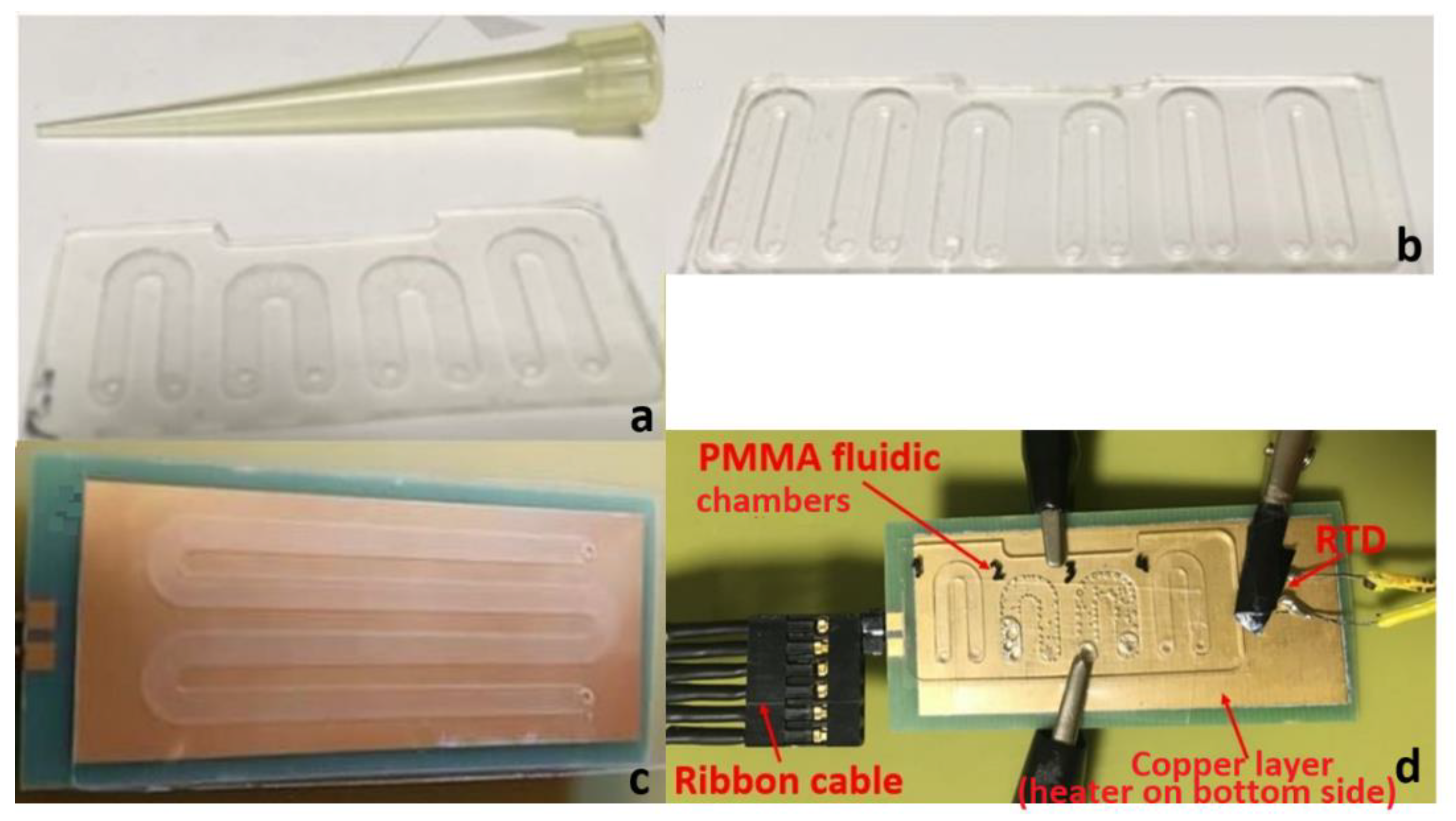

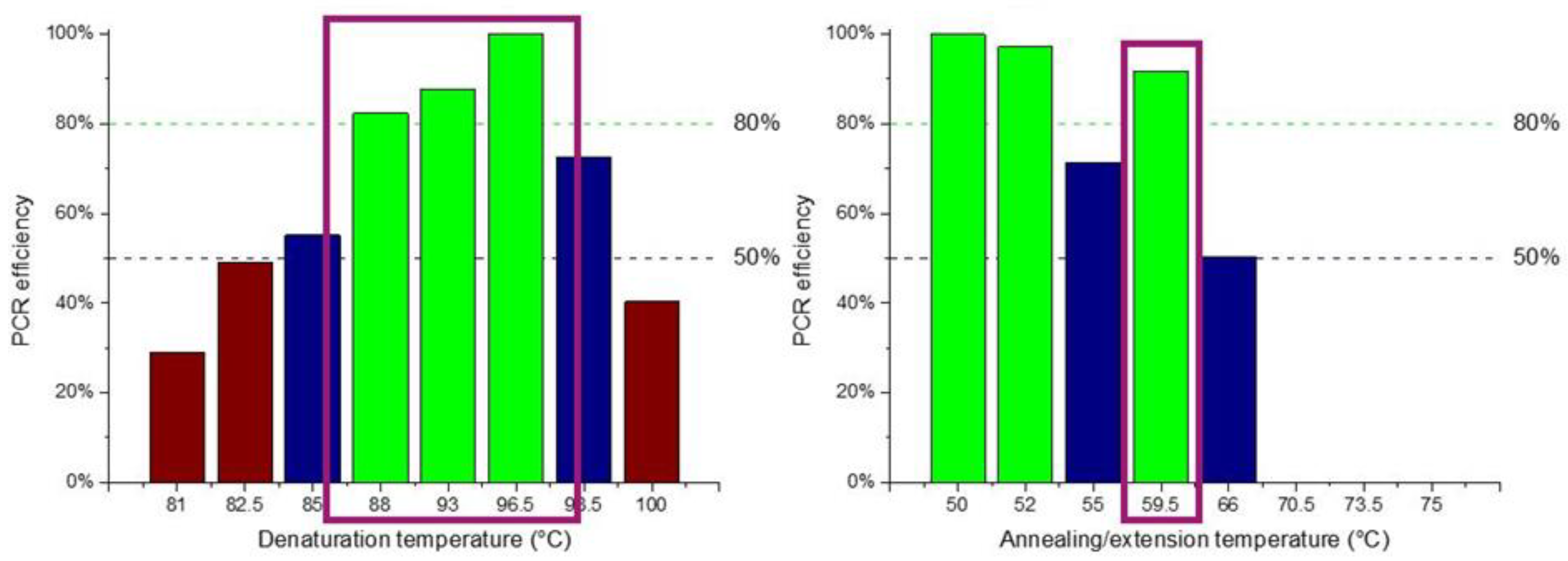


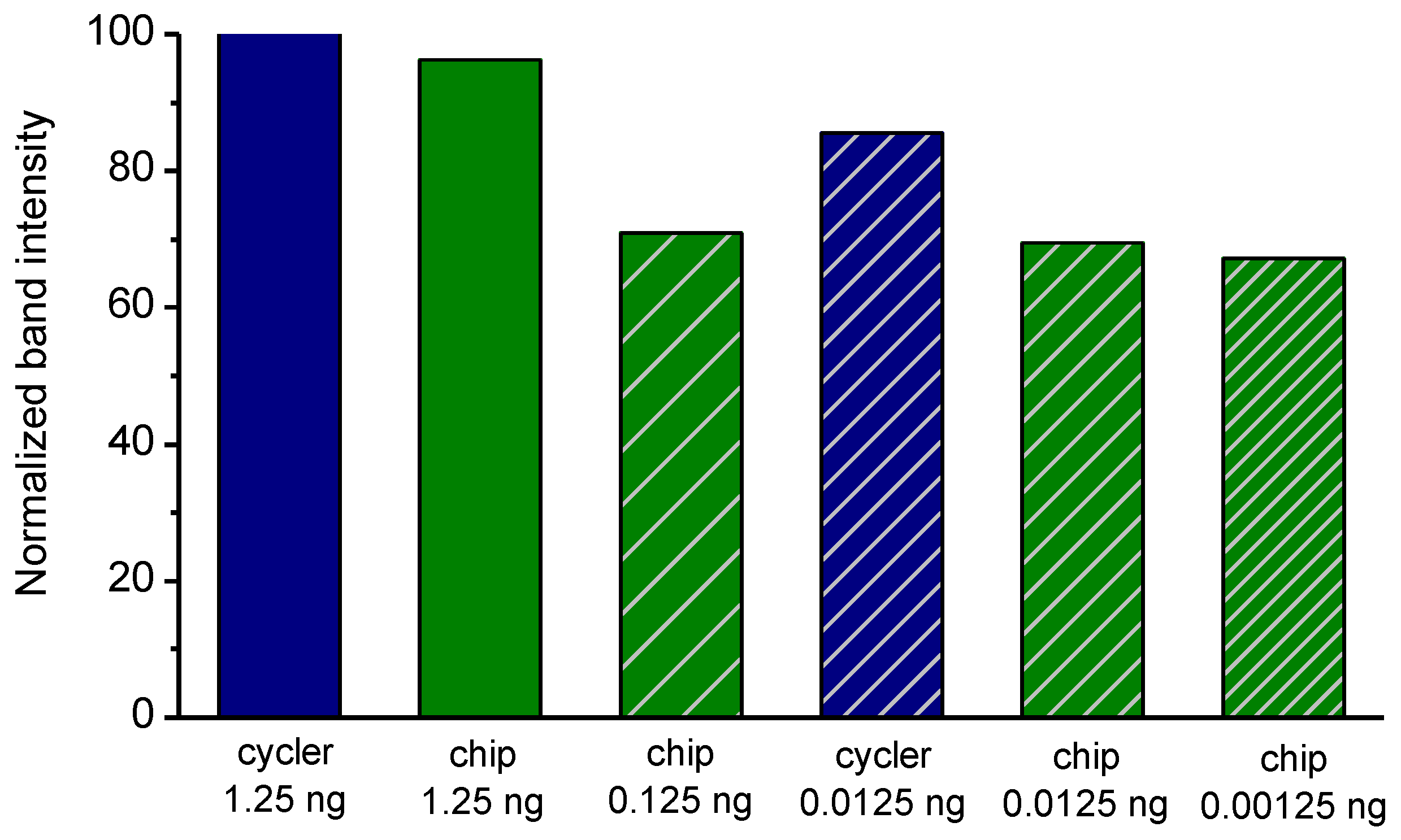

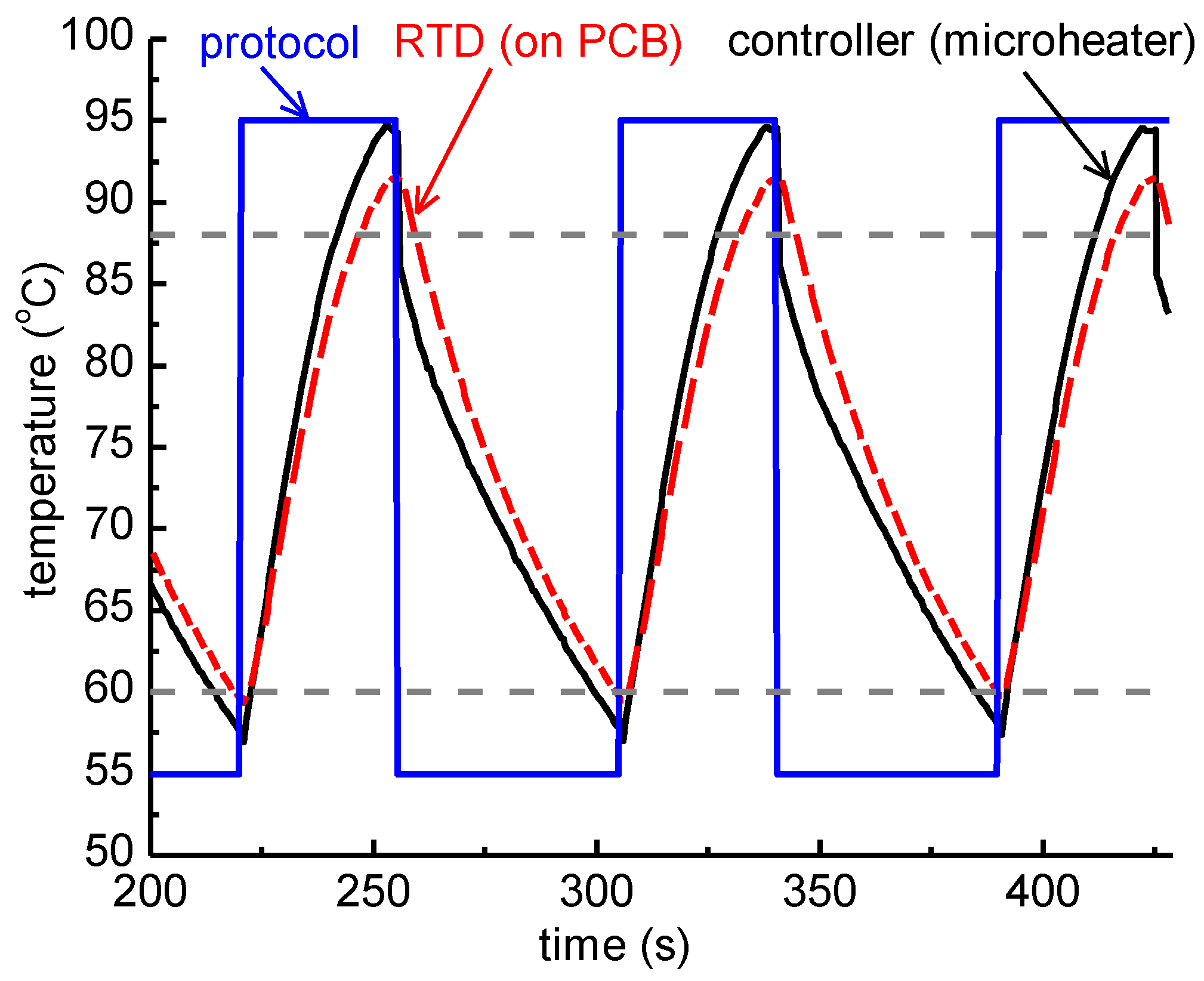

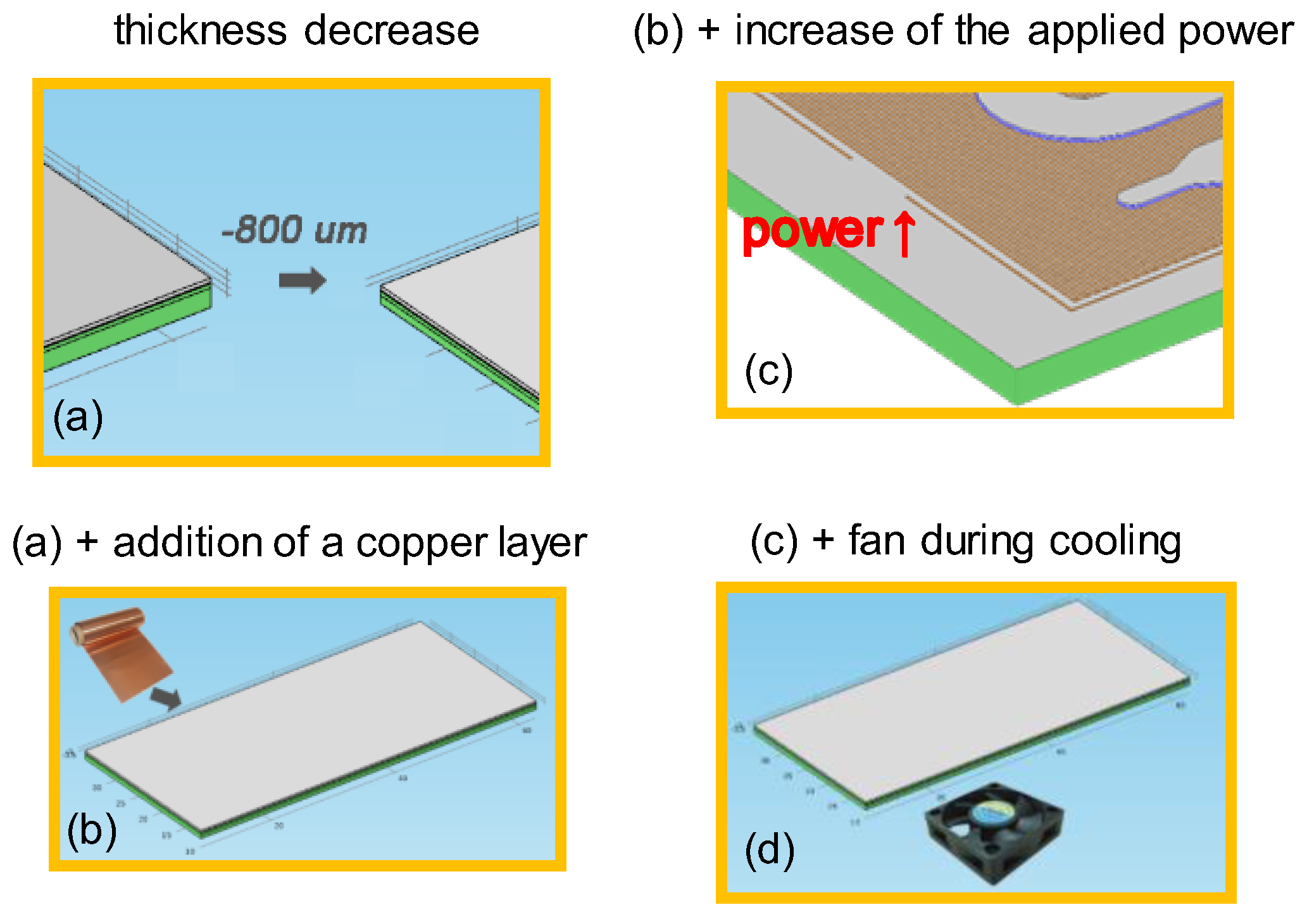
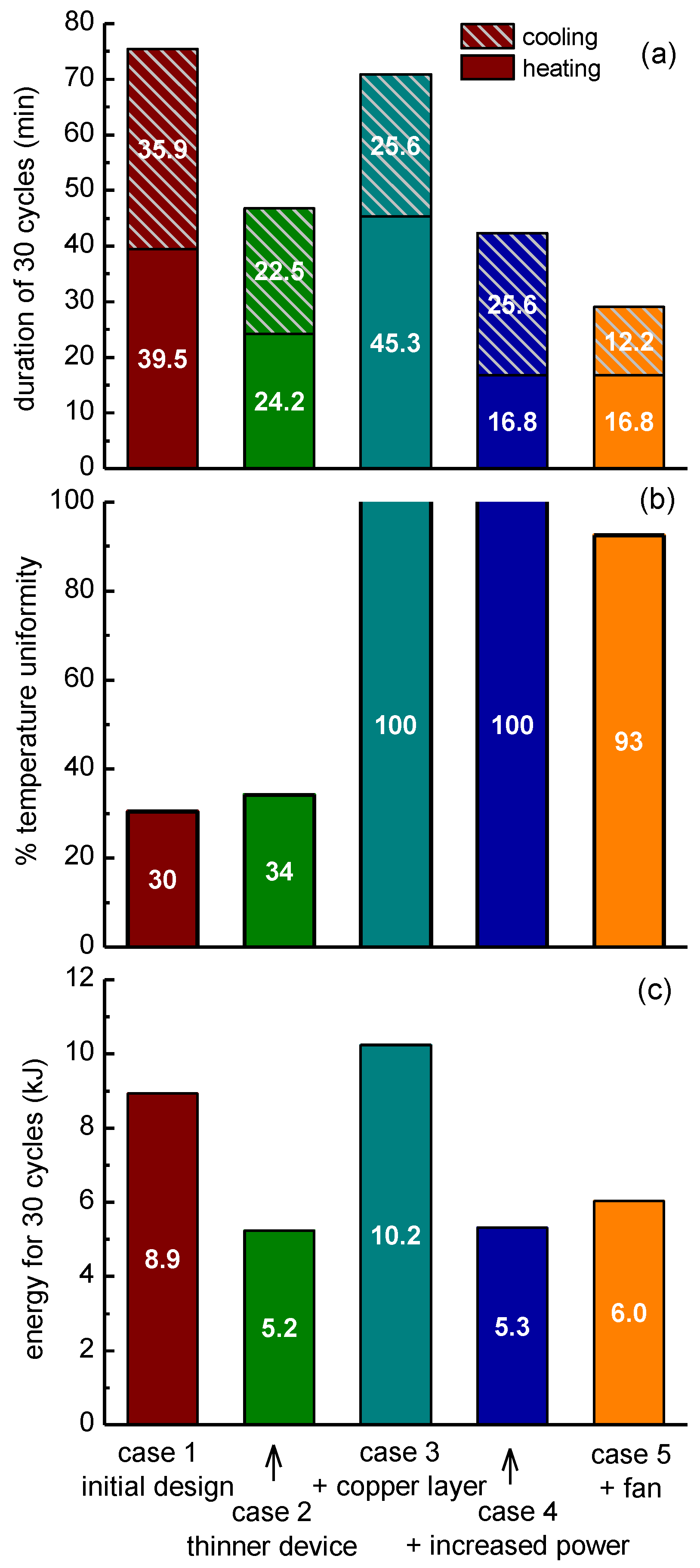
| 55 s at 55°C and 25 s at 90°C | RTD (on PCB) | Controller (at Microheater) |
|---|---|---|
| Residence time—denaturation (>88 °C) | 4.5 s | 3.3 s |
| Residence time—annealing/extension (<60 °C) | 3.7 s | 15.5 s |
| Cooling rate | 0.5 °C/s | 0.6 °C/s |
| Heating rate | 1.1°C/s | 1.4 °C/s |
| Variable | Thin Microheater (0.8 mm) with Copper Layer | Thick Microheater (1.6 mm) | ||
|---|---|---|---|---|
| temperature at | center | edges | center | edges |
| denaturation | 95 °C | 93 °C | 95 °C | 90.5 °C |
| annealing/extension | 65 °C | 63.5 °C | 65 °C | 62 °C |
| maximum power | 6.3 W | 4.9 W | ||
| energy per cycle | 150 J | 80 J | ||
| 50 s at 55 °C and 35 s at 95 °C | RTD (on PCB) | Controller (at Microheater) |
|---|---|---|
| Residence time—denaturation (>88 °C) | 13 s | 13 s |
| Residence time—annealing/extension (<60 °C) | 4.8 s | 6.7 s |
| Cooling rate | 0.6 °C/s | 0.7 °C/s |
| Heating rate | 0.9 °C/s | 1.2 °C/s |
| Comparison | Change | Duration | Energy | T-Uniformity |
|---|---|---|---|---|
| case 2 to 1 | case 1 with thickness ↓ | 38% ↓ | 41% ↓ | 34% |
| case 3 to 1 | case 2 + copper layer | 6% ↓ | 15% ↑ | 100% |
| case 4 to 1 | case 3 + power ↑ | 44% ↓ | 41% ↓ | 100% |
| case 5 to 1 | case 4 + fan | 62% ↓ | 32% ↓ | 93% |
© 2020 by the authors. Licensee MDPI, Basel, Switzerland. This article is an open access article distributed under the terms and conditions of the Creative Commons Attribution (CC BY) license (http://creativecommons.org/licenses/by/4.0/).
Share and Cite
Kaprou, G.D.; Papadopoulos, V.; Loukas, C.-M.; Kokkoris, G.; Tserepi, A. Towards PCB-Based Miniaturized Thermocyclers for DNA Amplification. Micromachines 2020, 11, 258. https://doi.org/10.3390/mi11030258
Kaprou GD, Papadopoulos V, Loukas C-M, Kokkoris G, Tserepi A. Towards PCB-Based Miniaturized Thermocyclers for DNA Amplification. Micromachines. 2020; 11(3):258. https://doi.org/10.3390/mi11030258
Chicago/Turabian StyleKaprou, Georgia D., Vasileios Papadopoulos, Christos-Moritz Loukas, George Kokkoris, and Angeliki Tserepi. 2020. "Towards PCB-Based Miniaturized Thermocyclers for DNA Amplification" Micromachines 11, no. 3: 258. https://doi.org/10.3390/mi11030258
APA StyleKaprou, G. D., Papadopoulos, V., Loukas, C.-M., Kokkoris, G., & Tserepi, A. (2020). Towards PCB-Based Miniaturized Thermocyclers for DNA Amplification. Micromachines, 11(3), 258. https://doi.org/10.3390/mi11030258





